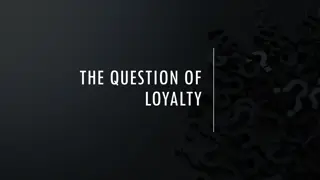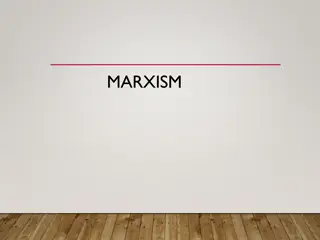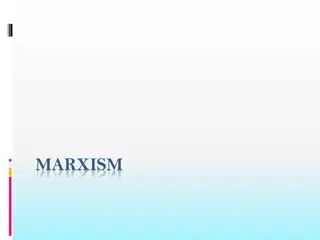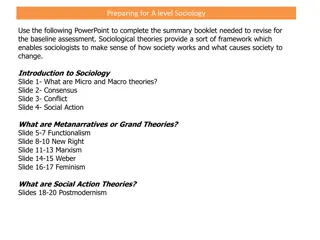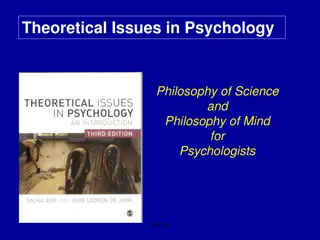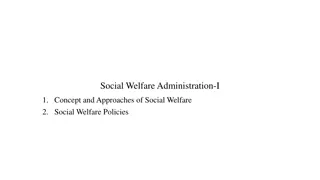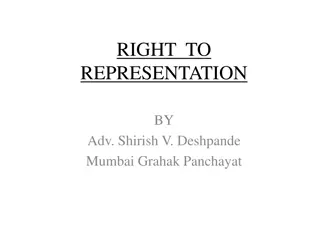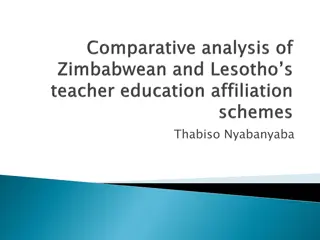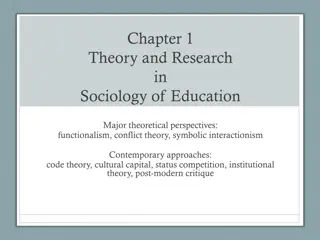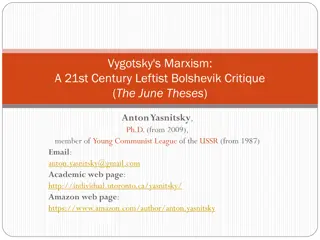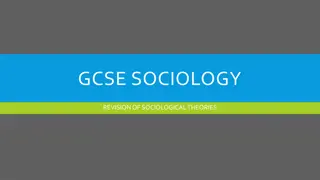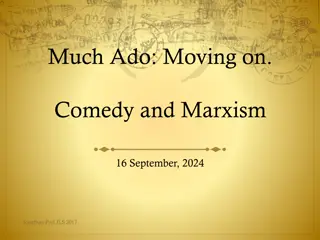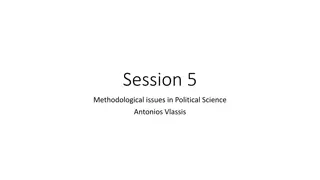Exploring Role and Purpose in Education: Insights into Functionalism, New Right, and Marxism
Delve into the various perspectives on education's role and purpose through the lenses of Functionalism, New Right, and Marxism. Uncover the differences in achievement between social groups, analyze external and internal factors influencing education, and explore educational policies. Criticisms, solutions, and evaluations are also discussed, offering a comprehensive view of the complex landscape of education theory.
Download Presentation

Please find below an Image/Link to download the presentation.
The content on the website is provided AS IS for your information and personal use only. It may not be sold, licensed, or shared on other websites without obtaining consent from the author. Download presentation by click this link. If you encounter any issues during the download, it is possible that the publisher has removed the file from their server.
E N D
Presentation Transcript
Education Topics Role & Purpose Functionalism, New Right, Marxism Differences in Achievement between social groups External Factors Material deprivation, cultural deprivation, cultural capital, gender socialisation Internal Processes Teacher labelling & self-fulfilling prophecy, setting/streaming, sub-cultures, pupil identities, curriculum Educational Policy Butler Act 1944, Comprehensivisation, New Right & ERA 1988, New Labour 1997-2010, Coalition 2010-2015
Role & Purpose Functionalist View Creating Social solidarity Teaching Specialist skills Durkheim Meritocracy everyone has an equal chance Bridge between the family and wider society Universalistic standards Parsons Davis & Moore Role Allocation
Role & Purpose New Right View Similarities with functionalism Key Criticism The current educations system is failing because it is run by the state. Inefficient Not answerable to consumers Low standards = less qualified workforce/less prosperous economy Some people are more naturally talented than others Favour an education system run on the basis of meritocratic principles Socialise shared values such as competition and national identity Solution:Marketisation Create an Education Market
Role & Purpose New Right View Chubb & Moe Education Vouchers Evaluation??
Role & Purpose Marxist View Althusser Education is an Ideological State Apparatus Reproduces inequalities by transmitting from generation to generation Legitimates inequalities through ruling class ideology Correspondence principle Hidden Curriculum Myth of meritocracy Bowles & Gintis Counter school sub-culture Paul Willis Don t forget to use Post-Fordism and postmodernism here Evaluation?
Exam Question: Outline three ways in which school may mirror work in capitalist society. hierarchical structure (1 mark); in schools head teacher at the top and students low down, in work boss at the top workers low down (+1 mark) rewards (1 mark); grades in school, pay in work (+1 mark) fragmentation (1 mark); school divided into unconnected subjects, work divided into unconnected tasks (+1 mark) degree of autonomy (1 mark); senior pupils/those in higher streams have more autonomy, managers/skilled workers have more autonomy (+1 mark) monotony (1 mark); having boring lessons, carrying out repetitive tasks at work (+1 mark) dress code (1 mark); in school you wear uniform to represent the school and in the workplace you wear uniform to represent the company/brand (+1 mark) legitimation (1 mark); in school pupils are taught that exams are fair and in work promotional opportunities are portrayed as fair (+1 mark)
Exam questions for this topic Applying material from Item B and your knowledge, evaluate the usefulness of functionalist views of the education system in society today (30) Short answer questions: 1. Outline and Explain two ways in which New right views on education are similar to functionalist (4) Outline three ways in which the education system serves capitalism (6) Outline two ways in which the schooling system may pass on values and ideas which are in the interests of dominant groups (4) Outline three ways in which schooling might contribute to social stability (6) 2. 3. 4.
Social Class Differences in Achievement External Factors Basil Bernstein Linguistic Deprivation Working class use the restricted code Middle class use elaborated code with wider vocabulary and more complex sentences - gives middle classes advantages at school Working class sub-culture has 4 features that are a barrier to educational achievement: Fatalism, Collectivism, Immediate gratification, Present-time orientation Middle-class children have cultural capital which helps at school. It includes knowledge, attitudes, language and tastes. Cultural and economic capital give middle-class families more choice of schools since marketization started. Barry Sugarman Pierre Bourdieu Sharon Gewirtz
Social Class Differences in Achievement Internal Factors Ray Rist Studied American kindergarten. Teacher labelled and grouped children as fast learners called tigers who were mainly middle class. She treated them differently from cardinals and clowns who were mainly working class Tested pupils and told teachers they had identified spurters (but these were chosen at random). They returned and tested pupils a year later. They found half had spurted. They concluded this was due to labelling and different treatment which led to a self-fulfilling prophecy Found that pupils place in low-streams (mainly working- class) lost self-esteem. Many then formed anti-school subcultures to gain status among peers. A-C economy sincemarketization has led to Educational triage . Schools ignore hopeless cases often working class and/or black which leads to self-fulfilling prophecy and failure Rosenthal & Jacobson Colin Lacey Gilborn and Youdell
Pupils class identities (new spec) Louise Archer (2010) Habitus (linked to Bourdieu s concept of habitus) Symbolic capital and symbolic violence Nike identities Nicola Ingram (2009) Working-class identity and educational success Sarah Evans (2009) Class identity and self-exclusion
Differences between social classes cannot be looked at totally separately to gender and ethnicity, you have to understand that these all interact with each other. However differences in educational attainment is more pronounced amongst social class than any other social group and therefore make it clear that social class is the most important difference.
Ethnicity & Educational Achievement External Factors Black lone parent families suffer cultural deprivation financially and because of lack of a male role model. This makes them underachieve. Daniel Moynihan Asian parents have positive attitudes to education and higher aspirations so Asian pupils will do well. Pakistanis and Bangladeshis s three times more likely than whites to be in poorest 20% of population and live in overcrowded households Driver and Ballard Flaherty
Ethnicity & Educational Achievement Internal Factors Racialised expectations led teachers to label black children and discipline them more than others for the same behaviour. Gillborn and Youdell Racist teachers discouraged black pupils form being ambitious Mirza Teachers stereotype black boys as rebellious, anti- authority and anti-school and they are therefore more likely to be excluded from school. Sewell Ethnocentric curriculum in British schools which prioritises white culture. This is an example of institutional racism Troyna and Williams
Gender & Educational Achievement External Factors Main reasons for girls rapid improvement in results The impact of feminism, changes in the family, changes in women s employment, girls changing perceptions and ambitions Interviewed girls in 1970s and 1990s. Found low aspirations in 1970s and priorities were low, marriage, husbands, jobs . In 1990s careers to support themselves were a priority. Sue Sharpe Girls spend leisure time differently to boys Hannon Crisis of masculinity traditional masculine roles are under threat and w/c boys perception of this may influence their motivation and ambition. Mac an Ghaill Boys have unrealistic career ambitions that are less likely to require academic success e.g. professional footballer Francis
Gender & Educational Achievement Internal Factors Stephen Gorard 1988 GCSEs were introduced and coursework. This favoured girls who then did much better than boys. Laddish subcultures form because working class boys who study are labelled as sissies or gay because they associate masculinity with being tough and manual work. Teachers encourage boys to be tough and girls to be quiet and helpful. This early socialisation shapes boys and girls interests and gender domains . Equal opportunity policies are key in girls improvements. Policies such as GIST and WISE encourage girls to pursue careers in male dominated areas. Teachers challenge stereotypes and gender stereotypes have been removed from text books. Debbie Epstein Eileen Byrne Jo Boaler Gaby Weiner
Identity, class and girls achievement Louise Archer (2010) Symbolic Capital Hyper-heterosexual feminine identities, boyfriends, being loud , and working-class girls dilemma Sarah Evans (2009) Successful working-class girls
Reasons for gender differences in subject choice Early socialisation Gendered subject images Peer pressure Gendered career opportunities
Pupils sexual gender identities Pupils experiences in schools help to construct and reinforce their gender and sexual identities. These experiences may contribute to reinforcing what Bob Connell (1995) calls hegemonic masculinity the dominance of heterosexual masculine identity and the subordination of female and gay identities: Double standards Verbal abuse The male gaze Male peer groups Source: Webb, R et al (2015) Sociology Book One, Napier Press
Applying material from Item B and your knowledge, evaluate the view that gender differences in educational achievement are the result of factors within schools. (30) Top band marking criteria for AO1, AO2 and AO3 Content to use to answer the question
Educational Policies You need to know the main phases of educational policy in Britain. You should be able to apply sociological perspectives to educational policies. You must be able to evaluate the impact of educational policies on inequality of achievement.
Education (Butler) Act 1944 Tripartite System 11+ exam decided which type of secondary school pupils would go to Grammar school (20%) Technical (5%) Secondary Modern (75%) GCSE O Levels studied at Grammar schools Later CSE s were introduce at Secondary Modern schools Impact 2/3 of grammar school places went to M/C children and 11+ test was biased in favour of M/C children The mainly W/C children that went to Secondary Moderns were labelled as failures and lacked the means and motivation to succeed Girls achieved higher so their pass rate was set higher as there were fewer girls grammar schools
Comprehensivisation 1965-1979 Intention Abolish selection at 11 and educate all children in one type of school regardless of class, gender, ethnicity or ability. Selection was now based on geography children would now go to their local school The Labour government instructed all local authorities to reorganise schools to become comprehensives not all of them did some grammar schools remained. Problems Catchment areas meant schools had little mixing of social classes and the better schools were in the M/C areas attended by mainly M/C children The tripartite system continued in some local authority areas Comprehensives organised their classes by ability using setting or streaming, this led to the lower sets or streams being dominated by W/C children and therefore social class inequalities remained.
New Right Policies (1979-1997) New Vocationalism The conservatives blamed youth unemployment on the failure of schools to teach work skills. They introduced: NVQs job specific qualifications studied p/t at college whilst also working f/t GNVQs studied in school as an alternative to academic qualifications Modern Apprenticeships combined training at work with college to gain NVQ Training schemes The YTS combined work experience with education employers had to ensure trainees followed a training scheme which led towards a Level 2 NVQ Criticisms Real purpose is to create good attitudes and work discipline so young people will come to accept a future of low-paid unskilled work Perhaps young people don t lack skills, perhaps there is a shortage of jobs. Lower ability students put on vocational courses this is another form of selection with a higher proportion of W/C and ethnic minority students Training schemes were often gender stereotyped with girls going into hairdressing and beauty and boys construction this is still the case today.
Education Reform Act 1988 Marketisation of Education included: Testing - students sat SATS at the ages of 7, 11 and 14, along with new GCSE and A levels. League Tables Test and exam results published in league tables and parents use these to make an informed choice of secondary school. Formula Funding schools receive an amount of funding per pupil. National Curriculum All schools would have to teach a range of subjects Opting Out Schools could now opt out of LEA control and decide how to manage their own budgets.
Education Reform Act 1988 Criticisms Concern over damaging, stressful affects on children on testing children so often. Schools would now only teach to test . League tables could lead to low achievers not being entered for exams, or because of competition schools spend large amounts of money on marketing the school rather than educating pupils. Formula funding would lead to popular schools gaining more funds and so could afford better qualified teachers and better facilities and attract more able/ambitious, generally M/C applicants. Parentocracy is a myth M/C parents had more cultural and economic capital they could make more informed choices OR move into a catchment area of a good performing school. Therefore reinforced social class differences again!
New Labour 1997-2010 New Right Influenced Policies Specialist schools schools could apply for a specialist status, which could gain extra government funding. Specialist schools can select 10% of students based on aptitude for their specialism. Work-related Learning Allow schools and colleges more options in providing vocational education this is facilitated by raising school leaving age to 18, which would also reduce NEETS University Fee s introduced and grants replaced with loans. Social Democratic Policies Academies to replace failing schools in poor areas, this led to private businesses becoming involved in state education Education Action Zones More funding and support for schools in deprived areas Sure Start wide range of educational and support services in disadvantaged areas EMA available to 16-19 year old in f/t education from families on low incomes to encourage young people to stay in education
New Labour 1997 - 2010 Criticisms Contradictions in New Labours policies in tackling inequality and it s commitment to marketisation. Perhaps their anti-inequality policies are cosmetic and don t actually reduce inequalities. (EMA contradicted by Uni fees) Labour are opposed to private schools for the privileged classes, but grammar and private fee-paying schools continue to exist when Labour could have abolished them. Focus still on exam results and league tables mean M/C have gained most from their policies. Increase in university entrants under New Labour, but more so for M/C Overall opportunities have increased for everyone, but class inequalities remain. Does this just reflect society?
Coalition Policies 2010 - 2015 English Baccalaureate (EBacc) Students to study English, Maths, Science, Humanities & MFL Pupil Premium Pupils qualifying as FSM, LAC and from Service families gain extra funding to raise attainment/reduce inequality Reformed A levels & GCSE s Move from modular to liner exams, reduction of course work, new number categories for GCSE Scrapped EMA and replaced with bursary Some students from poorest families still receive help, but this is at the discretion of the school and is generally a lower amount and available to fewer students Rise of University fees to 9000 per year Reduced university entrants?, more students live at home, poorer students need to work p/t, much larger debts to pay back.
Exam question: Identify three ways in which selection policies may widen social class differences in educational achievement (6) One way is through the introduction of the 11+ exam. Middle class students are more likely to pass this exam and go to a grammar school where they study an academic curriculum and are more likely to achieve better exam results. A second way is through streaming. Working class students are more likely to be placed in lower streams meaning they are unlikely to achieve the top grades. A third way is catchment areas. Successful, over-subscribed schools may only be open to those who can afford to live in the area, which is normally middle class families. This answer would achieve full marks. Each way is clearly identified. Each way is explained and clearly focused on the question
Outline two ways in which educational policies may have affected the experience of minority groups in education (10)* *This is an AS question, for an A Level paper you would have an item to apply material from
Exam questions to try Outline two criticisms of the comprehensive school system (4) Outline three ways in which marketisation is shown in the education system (6) Outline three reasons why Government education policies aimed at reducing inequality may not always succeed (6) Analyse two polices creates to improve education for disadvantaged students (10)
Methods in Context Read back over methods in context sections in text books and your class notes. Remind yourselves of the studies we ve looked at and make sure you can evaluate any research methods used to research issues in education. When answering this question it is not enough just to evaluate a method using PERVRT, you must relate it to the topic being studied within education
Exam Advice Education Section (60 minutes) Q1. Define a key term (2 marks) Q2. Using an example explain (2 marks) Q3. Outline three reasons/criticisms/functions/policies (6 marks) Q4. Outline and explain two reasons . Mini essay (10 marks) Q5. Essay purely on education remember to use the item (30 marks) Methods in Context (30 minutes) Q6. Essay linking a topic in education to a particular research method. (20 marks) E.g. Using Item B and your knowledge of research methods, evaluate the strengths and limitations of using _____________ to investigate___________________



